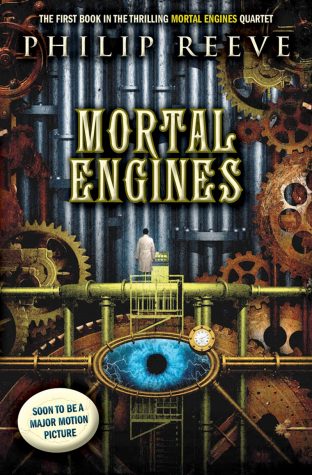Book review: Philip Reeve’s “Mortal Engines” is a wildly imaginative ride
In anticipation for next month’s film adaption of “Mortal Engines,” one WSS reporter reviews the original dystopian-steampunk novel written by Philip Reeve.

“Mortal Engines” takes place on a dystopian, post-apocalyptic Earth as cities have risen up from the ground and donned wheels, becoming large, mobile fleets. These new, mobilized cities all follow the rules of Municipal Darwinism, a play on Charles Darwin’s famous “survival of the fittest” by scavenging smaller cities and capturing them.
Tom Natsworthy, an apprentice historian working in the futurized version of London, finds himself thrown off London in an apparent accident that results with him stuck on the ground with the mysterious, scar-faced Hester Shaw. They are forced to work together to try and make it back to London in order to learn the truth behind the city’s motivations and the future of their world.
The book is written by Philip Reeve, an author who has written a plethora of young-adult fantasy novels, with the Mortal Engines series being his most famous. While his novels, primarily “Mortal Engines,” have been on my to-read list for a while, I had withheld reading them for a long time. However, with the big screen adaptation to be released next month, I figured now would be the perfect time to start reading.
The premise is the primary cause “Mortal Engines” peaked my attention. Looking through the plot synopsis, there was a lot to be intrigued about concerning the plot and conception; while the idea of moving cities does come off as far-fetched upon first glance, it had potential to work depending on how Reeve would play it off. In the end, Reeve ends up succeeding – not only is he able to make the concept work out surprisingly well, but he also pens a charming, well-written tale that revolves around strong, unique characters.
The writing is a large reason as to why “Mortal Engines” succeeds. Reeve’s way of telling the story is clever and entertaining; he infuses a trademark writing style into the novel, and the writing rarely feels awkward or disjointed. He juxtaposes the serious, character-driven moments and the humorous moments with ease and always seems to know is doing, telling the story in an impeccable, smooth manner.
Reeve also succeeds in visualizing the novel’s landscape. His vivid descriptions of the grandiose scenery are imaginative and creative, and the descriptions never feel excessive or over-detailed; they portray the right mix of thoughtfulness and descriptive worldplay to paint a clear picture of the visuals in your head, and allow you to clearly understand the scope of the story without overloading your senses with spectacle.
For a novel like this, a considerable amount of exposition and worldbuilding is to be entirely expected. Unlike lots of other novels, however, this area is pulled off reasonably well. Where many novels feel the need to pack all of their exposition into one single part of their story, “Mortal Engines” refrains from pushing too much worldbuilding at a time. Instead, explanations of the story’s backdrop and history are sprinkled throughout and flow naturally within the context of the plot.

Tom Natsworthy takes the role of the main protagonist in “Mortal Engines.” I initially thought his character came off as contrived when first introduced to him – he’s lonely, his parents are dead, he has been lied to his whole life, etc. However as the story pounds forward, my initial critical reaction began to dissipate. “Mortal Engines” packs in enough character depth, confliction and personality to overcome what was an admittingly generic backstory for the character.
The other main character is Hester Shaw. Her story in “Mortal Engines” is based around seeking revenge against Thaddeus Valentine, an explorer from London who killed her parents and severely disfigured her face. Reeve does not hold back in describing her features and how grotesque and hideous the scar makes her facial features look; as such, Hester grapples with a sense of self-identity throughout “Mortal Engines,” and her motivations and conflicts are completely understandable. The book does a fantastic job at pushing the point that looks do not determine a person’s character, and Hester is a great representation of that message.
Thaddeus Valentine is the story’s main villain, a secretive explorer who works with his daughter aboard London. Luckily, he does not fall into the “generic villain” trap. He isn’t soulless, and he has an actual, clear reason for his actions. Even though he is missing for the bulk of the novel, he steals all of the scenes that he is in.
If there was anything that I found to be a fault in “Mortal Engines,” it is the novel’s length. With a length of just under 300 pages, several of the inner plotlines feel like they had to be rushed in order to move the main story forward. As there are still three novels to come in the “Mortal Engines” quartet, I felt like some of these subplots could have been saved for larger use in future novels rather than being crammed in to an already packed story.
There are four novels in the series: “Mortal Engines,” “Predator’s Gold,” “Infernal Devices” and “A Darkling Plain,” as well as a prequel series consisting of “Fever Crumb,” “A Web of Air” and “Scrivener’s Moon.” If the first entry in the series is any indication of what’s to come, then I am definitely in for quite a ride.
Lots of people are going to automatically dismiss “Mortal Engines” as a novel pandering only towards teenagers or children, however this is not the case. The writing and story are indeed simple enough for young audiences to understand, however there are also many elements and messages weaved in for adults and older teenager audiences to appreciate as well. Grade: A
The film adaptation of “Mortal Engines” will be directed by Christian Rivers and produced by Peter Jackson, the visionary behind the epic fantasy film series “The Lord of the Rings.” The film is set to be released worldwide on December 14th.
Your donation will support the student journalists of West High School. Your contribution will allow us to purchase Scholarship Yearbooks, newsroom equipment and cover our annual website hosting costs.

Edward Keen is a senior and this is his second year on staff, where he is Arts Editor. In his free time, he enjoys reading.



